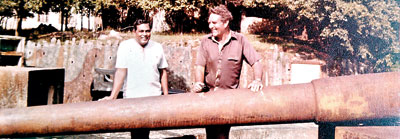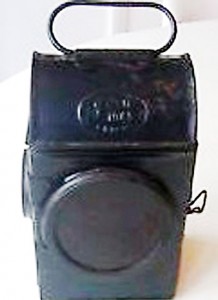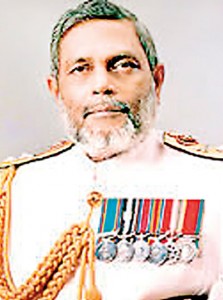A missing link
It all started when my father stumbled upon a small railway lamp discarded in the dungeons of the Ceylon Naval Armament Depot (CNAD) within the Naval Dockyard at Trincomalee. Made by Sherwoods Ltd., Birmingham, U.K., the lamp is black with a red glass lens. My father connected the lamp with the small independent railway line within CNAD Trincomalee which is a ‘Highly Restricted Area’.

The beginnings of a great interest: 1984- Capt. Clancy Fernando and Lt. Charles Searle (Royal Navy) at Hoods Tower in the Naval Dockyard Trincomalee
This was back in 1984 when my father, Admiral Clancy Fernando was serving as the Commandant of the Naval and Maritime Academy of the Sri Lanka Navy, situated within the Naval Dockyard at Trincomalee. A Dartmouth-trained Naval Officer and Master Mariner, he was also ‘master’ of many other spheres and naval history was one of them. Many of his historical findings have been hijacked by other pseudo-historians over time, but this search he initiated for the Royal Navy Railway in Ceylon is continued and dedicated to him on his 22nd death anniversary which falls today, November 16.
My father had a deep love for Sri Lanka and Trincomalee was dearest to his heart. Both left a profound impression on our family. Trincomalee attracted us in many ways. Chief among them was, of course, the great Navy. The Naval Dockyard was a treasure trove of mystery and history – abandoned ships and boats, ancient forts and dungeons, cannons and guns, watch towers and bunkers of the two World Wars, all interwoven with thick jungle. That jungle, a ‘declared sanctuary’ had sambhur, Spotted Deer, porcupine, pangolin, hare, monkeys, pythons, scorpions, a variety of birds and hordes of ticks as well! Up until recently it had elephants too. Most of these jungle-capped hillocks slope down to beaches in stunning bays and coves with crystal clear water.
It was here that my brother and I would accompany our father in his search for the history of this military bastion of many centuries. He chased up its history with many sources locally and overseas especially in Britain, exchanging information and ideas with eminent personalities knowledgeable on historical matters connected with Trincomalee. I was 14 then and my brother Dinukh, a year younger and we would make use

The discarded railway lamp
of every opportunity to spend time with our father in his patch of paradise which was the Naval Dockyard.
My father also served as Commander Eastern Naval Area and Security Forces Commander of the Trincomalee District. We again had the opportunity of spending many days roaming all over this naval base and Trincomalee in general, up until about 1990 when he was appointed Chief of Staff of the Sri Lanka Navy and had to come to Colombo. During these long stints he accumulated a hoard of information on Trincomalee, its history, especially its military role and wrote many articles, some of which were published. However, he was not able to pursue the railway link but he always told us that his retirement one day would be at Trincomalee and he would complete its military history leisurely.
Sadly he was assassinated by the LTTE on November 16, 1992 whilst he was Commander of the Sri Lanka Navy and most of his research was shelved.
With the Sri Lanka Railway celebrating a milestone in December, I decided to pursue the history of the Royal Navy Railway at Trincomalee, though I am no historian or academic – only an amateur led by the spirit of adventure ignited by my late father.
The Ceylon Government Railway network was initiated around 1858 by the British. The railway network in Ceylon was largely built to the 5’6” broad gauge and 2’6” narrow gauge, though in some instances it had mixed gauge lines as well.
David Hyatt in his authoritative book ‘Railways of Sri Lanka’ states there were a number of independent railways which were ‘industrial’ in nature. He makes reference to the Colombo Port Commission railway; the Cement Factory railway at KKS, Palavi and Galle; the Oils & Fats Corporation railway at Seeduwa; the Ceylon Salt Corporation railway of 60cm gauge at the salterns of Palavi, Hambantota and Elephant Pass; the Colombo Tramway System of 3’6” gauge; the Ratmalana Works railway; and the Viharamahadevi Park railway.
Interestingly there is no mention of an independent railway network in Ceylon connected to the Royal Navy, leave alone Trincomalee.
Hyatt and other experts who wrote books about the railway always captured the civil and industrial role but hardly touched on the military aspect.
The British Military is synonymous with extensive broad gauge and narrow gauge railway networks in Britain and many other locations around the world in its former empire. They are mostly in military establishments and Government-owned explosive sites. Hence, they were most often than not covered by the ‘Official Secrets Act’ and other restrictions which prevented them being well documented. So Mr. Hyatt and others could be excused for not covering them.

Admiral Clancy Fernando
In my search l honed in on the Royal Naval Armaments Depots (RNAD) – because the independent rail network at the Ceylon Naval Armament Depot (CNAD) Trincomalee, was formerly the Royal Naval Armament Depot (RNAD) Trincomalee.
I found much information about the RNAD Trecwn which I will compare with the CNAD Trincomalee. Strangely RNAD Trecwn was built in 1938, the year my father was born and decommissioned in 1992, the year he was assassinated. Located on the former North Pembrokeshire and Fishguard Railway, in West Wales, U.K. with cavern storage chambers and above ground network of storage sheds/military buildings, RNAD Trecwn had a herringbone layout along the valley giving access to 58 cavern based storage chambers, each approximately 200 feet in length hewn into the rock of the valley sides. The original RNAD Trincomalee would have been built before 1905. This is because the base was closed from 1905-23 according to H.A. Colgate.
Further in a plan of ‘Trincomalee Ostenburg’ by the Surveyor General’s Office, Colombo dated 1922-24, the original RNAD Trincomalee appears in some form. However, this layout is very different to the present layout and does not indicate cavern storage chambers nor rail links but with just one Magazine and many other buildings. But at present, CNAD Trincomalee has four cavern storage chambers accessed via four tunnels. Tunnel 28 & 29 had been built in 1931 and Tunnel 44 & 45 in 1939. They all have railway lines with sidings and I have been inside all of them. There are many above ground buildings some of which I suspect are from the earlier complex.
RNAD Trecwn during the height of the cold war had employed 400 permanent workers who had been housed in the MoD-built town infrastructure. At Trincomalee, a drive to the Museum at Hoods Tower through the Naval base or a visit to Sober Island Resort will give any civilian a glimpse of what infrastructure had been built by the Royal Navy at Trincomalee under direction of the British MoD. People like me who had the privilege of roaming through almost every inch of the base know what lies covered by the jungle even today. However, not all of this was built to service CNAD Trincomalee but the larger Royal Naval Base. Hence, the numbers employed at CNAD Trincomalee would be a fraction of the 400 at RNAD Trecwn. According to H.A.Colgate, when the Trincomalee Naval Base was closed in 1905 it put about 700 men out of work.
The next important aspect was the fire-fighting system. RNAD Trecwn had two reservoirs built into the hillside on opposite sides of the valley to supply high pressure water to the on-site fire hydrants. At CNAD Trincomalee, large underground wells provide water to the on-site fire hydrant system.
RNAD Trecwn could be accessed by workmen through the standard gauge rail networks of Great Western Railway or British Railway up to a platform south of its main entrance. Further it was also connected to the Fishguard harbour (which was a deep sea port just like Trincomalee) and Pembroke Docks by standard gauge railway where locomotives of both networks hauled MoD/Royal Navy privately owned wagons. The marshalling yard within RNAD Trecwn’s security perimeter had 8 parallel loops of standard gauge shunted by a dedicated MoD diesel hydraulic. The line then reached a gauge exchange shed for access to the narrow gauge line. However, at CNAD Trincomalee there is no trace of an outside connection to a standard gauge railway now but of course the narrow gauge line reaches the CNAD pier within the complex which would have made it possible for the easy transfer of munitions to Royal Navy Ships.
Presently at CNAD Trincomalee no other infrastructure connected to the railway system such as locomotives, wagons and locomotive sheds are to be found if they ever existed.
An interesting reference in page 154 of Hyatt’s book lists the acquisition of a locomotive from the Royal Navy in Trincomalee by the Oil & Fats Corporation Seeduwa: “CPC number 13 was purchased secondhand from the Navy Stores, Trincomalee by the Oils and Fats Corporation (Seeduwa) on 2nd January 1950 but immediately loaned to the CPC. In 1954 it was returned to the OFC.”
This locomotive was the only Bagnell in the CPC inventory. It was built in 1945 by Bagnell, in Stafford, England and assigned number 2823. It had a wheel arrangement of 0-4-0ST and was broad gauge 5’6”. Therefore, this locomotive could not have run on the 2’6” narrow gauge lines inside CNAD Trincomalee.
There is further reference in page 158 of Hyatt’s book regarding two other locomotives of the Royal Navy in Trincomalee: “Two diesel-mechanical 0-4-0 locomotives DC 2102 and 2103, built in 1937, are mentioned in Indian Locomotives. They were used by the Royal Navy in Trincomalee.”
No further information of these two locomotives is available. However, it is important to note that they had been ‘used by the Royal Navy in Trincomalee’.
The Ceylon Government Railway reached Trincomalee in 1920 and the line had seven odd spurs. One of them would have definitely been to the Oil Tank Farm & Oiling Jetty at China Bay. It may be possible that the Royal Navy operated locomotives in that complex.
The senior most surviving Commander of the Navy and one of the officers who took over the Royal Navy base in Trincomalee from the British on October 15, 1957, Admiral Basil Goonesekera did not recall much of the CNAD railway beside what remains now. Commander G.B. Jayasundera who served as Naval Armament Officer during my father’s period in Trincomalee recalled that new pallet trucks were introduced during his tenure.
However, many questions remain unanswered.
From what did the railway lamp come?
What was the motive system used at CNAD Trincomalee?
Where did the Royal Navy run its broad gauge Bagnell locomotive which they disposed of in 1950?
Where did the Royal Navy use locomotive no.s DC 2102 & 2103 in Trincomalee?
More importantly where is Locomotive CPC 13 which was originally from the Royal Navy in Trincomalee? It is last recorded as stored inside the Dematagoda Running Shed. Ideally it should be restored by the Sri Lanka Navy and displayed at the Naval Museum at Hoods Tower, Trincomalee rather than rusting away at Dematagoda.
Whilst most experts and rail enthusiasts here are sceptical of the existence of a Royal Navy Railway in Ceylon, I’m convinced of its existence back then. All this is thanks to my father who was my guiding light in the first 22 years of my life and has yet remained a star in the sky guiding me.
May he attain the supreme bliss of Nibbana.
(Any information on the Royal Navy Railway in Trincomalee would be welcome and could be sent to nishanfernando70@gmail.com)


